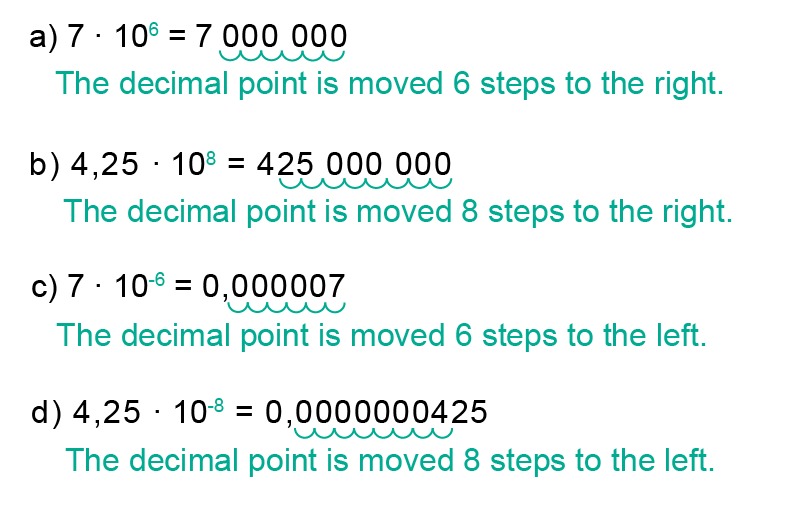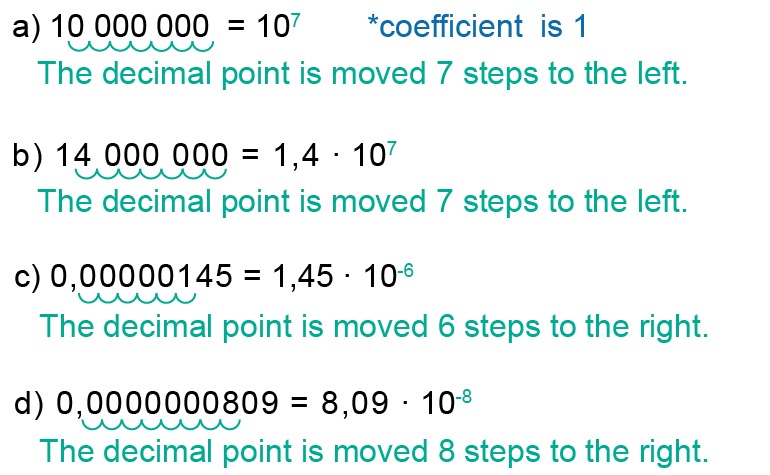7. Scientific expressions
Exercises
Scientific expressions
Scientific expressions are used to express numbers that are either very large or very small. For example, the number of atoms in the human body (4,000,000,000,000,000,000,000,000,000,000) can be represented by using a scientific expression as follows:

Scientific expressions
Large numbers can be expressed with scientific expressions:[[$ a\cdot 10^n, $]]
where [[$ 1 \leq a \leq 10 $]] and n is a positive or negative integer.
Converting a scientific expression into a normal number
If the exponent of number ten is
- positive, the decimal point is moved to the right
- negative, the decimal point is moved to the left
by the number of steps marked in the exponent.
Example 1
Write the numbers without scientific expressions.

The number 120 can be represented in the form [[$ \text{1.2} \cdot 100 $]]. When multiplying it by one hundred, move the decimal point two steps to the right. The same number in a scientific expression form is [[$ \text{1.2} \cdot 10^2 $]].
The number 0.034 can be written in the form [[$ \text{3.4} \cdot \text{0.01} $]]. When multiplying it by one hundredth, the decimal point is moved two steps to the left. The same number in a scientific expression form is [[$ \text{3.4} \cdot 10^{-2} $]].
Example 2
Write the numbers with scientific expressions.* If the coefficient of the expression is 1, it is not written down.

Names and signs
Some of the bigger numbers have their own names:
There are also commonly used multiplier unit prefixes for some units. One of the best known prefixes is kilo [[$ (10^3) $]]. Common prefixes are often used instead of scientific expression forms. For example, it is preferable to describe a mass as being 23 kg rather than [[$ \text{2,3} \cdot 10^4 $]] g, or a distance as being 17 km rather than [[$ \text{1,7} \cdot 10^4 $]] m.
b) millimetres
c) micrometres and
d) nanometres.
Solution:

* The metre is chosen as the basic unit of examination. Note that the coefficients of the scientific expressions transform the numerical values into metres (mm = 10-3 m) and that we now want to complete the conversions in the other direction.
| Name | Number of zeros |
|---|---|
| million | 6 |
| billion | 9 |
| trillion | 12 |
| quintillion | 18 |
| septillion | 24 |
| nonillion | 30 |
| undecillion | 36 |
| tredicillion | 42 |
| googol | 100 |
| Name | Symbol | Base 10 |
|---|---|---|
| giga | G | [[$ 10^9 $]] |
| mega | M | [[$ 10^6 $]] |
| kilo | k | [[$ 10^3 $]] |
| hecto | h | [[$ 10^2 $]] |
| deca | da | [[$ 10^1 $]] |
| deci | d | [[$ 10^{-1} $]] |
| centi | c | [[$ 10^{-2} $]] |
| milli | m | [[$ 10^{-3} $]] |
| micro | μ | [[$ 10^{-6} $]] |
Example 3
The diameter of a water molecule is [[$\text{2,8} \cdot 10^{-8}$]] cm. Express the diameter in
a) metresb) millimetres
c) micrometres and
d) nanometres.
Solution:

* The metre is chosen as the basic unit of examination. Note that the coefficients of the scientific expressions transform the numerical values into metres (mm = 10-3 m) and that we now want to complete the conversions in the other direction.